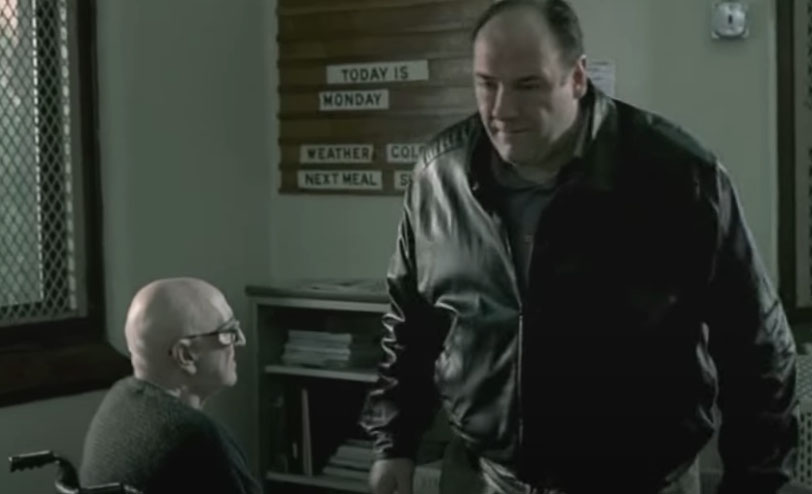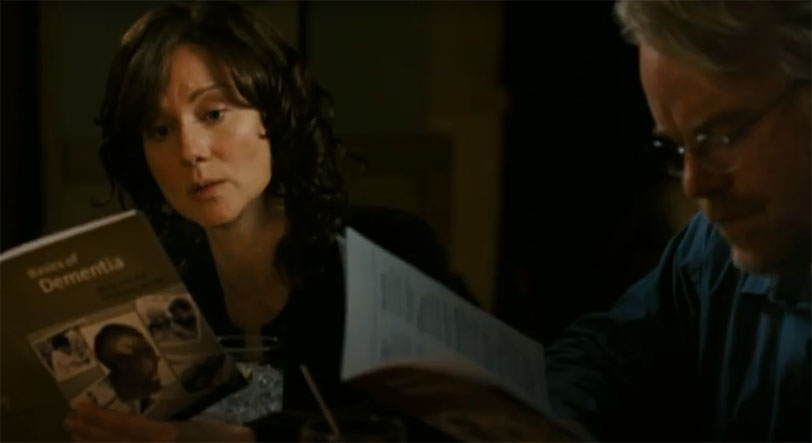In the last decade alone, two actors have won Academy Awards for starring roles depicting persons living with Alzheimer’s disease. These powerful performances by Julianna Moore (Still Alice) and Anthony Hopkins (The Father) were rightfully rewarded with Hollywood’s top prize while shining a spotlight on the many challenges faced by those who suffer from dementia.
Naturally, any serious on screen examination of dementia will of course include the prominent role of family caregivers. These characters may be an unsung hero faithfully serving someone living with the disease for years. Or perhaps, they are an adult child thrust onto the scene in a time of crisis or transition. Each caregiver scenario we see in the theater or streamed across our television screen provides a unique look at the art of caring for others.
Just as it is in real life, caregiving on screen is the ultimate supporting role. We took a look at a few dementia-focused storylines from movies and television to examine what they got right about the caregiver experience.
Warning: You will find some plot spoilers ahead, though we have tried to avoid giving away key plot points and story endings whenever possible.
Still Alice Shows Heartbreak of Early-Onset
This 2014 film, based on the bestselling book by first-time author and Harvard Neuroscientist Lisa Genova, shines a light on the devastation and range of emotions that come with a diagnosis of early onset Alzheimer’s disease. Julianne Moore’s Academy Award-winning performance of Alice Howland takes us through her journey, from receiving her diagnosis from a specialist in neurology to breaking the news to her family. A series of heartbreaking sequences show Alice inform her children that her type of dementia is considered familial, meaning that her kids run a significant risk of developing the disease later in life.
This film does an excellent job illustrating the progression of the disease. Scenes featuring a blurred background and other film techniques bring to life just how disorienting the disease can be for those who suffer from it. Alice meets with the neurologist throughout the film and their discussions provide important benchmarks as she moves through the various stages of the disease. “You have sporadic memory impairment totally out of proportion to your age,” the doctor tells Alice early in the film. “And there is evidence of decline in your level of mental function.”
Perhaps the most powerful scenes in Still Alice involve Alice’s interaction with family members and we see some of them progressively transition into her primary caregivers. Her husband (portrayed by Alec Baldwin) seems to struggle coping with his brilliant wife’s cognitive decline, though his support does improve as the film goes on. Their daughter Lydia (Kristen Stewart), an aspiring actress whose career choice was often at odds with her mother’s hopes for her gifted daughter, seems to relish the role of caregiver to her mother. This dynamic makes for some truly beautiful scenes throughout the film’s third act.
The Sopranos Takes Family Dynamics to the Extreme
As semi-retired mob boss Junior Soprano’s apparent dementia progresses throughout the iconic HBO series, a very interesting dynamic unfolds. Junior’s increasing paranoia, a symptom of the disease that should set off alarm bells, instead triggers the paranoia of current head of the Soprano crime family: his nephew Tony.

As a viewer, Tony Soprano’s always ignorant and often contentious approach to his Uncle’s cognitive decline can be frustrating to watch. Ever the narcissist, Tony makes his Uncle’s plight all about Tony, demanding he is cared for at home rather than approving a potential move to assisted living. Surrounding this issue, Tony’s main concern is that if his uncle were to move to a congregate setting, he might speak out of turn and tell the wrong person the wrong thing about the “family business.” On top of it all, many times throughout this plotline Tony appears to be skeptical that Uncle Junior’s decline is even real. In Tony and Junior’s final scene together—set in some type of care setting with bars on the windows—Tony interrogates a confused, less defiant version of his uncle. “You don’t know who I am, do you?” Tony finally says, before abruptly ending his visit.
The dysfunctional nature of the Soprano family aside, one thing that the show got right was the family dynamics involved in being a family caregiver. In Uncle Junior’s case, somebody had to step up and support his increasing care needs, and his niece (Tony’s sister Janice) filled that void. Yet, she was often minimized by her volatile, controlling brother. Also a mother to a young child, Janice would be considered a Sandwich Generation Caregiver, further complicating an already difficult daily landscape.
The Savages Learn What It Means to Be Caregivers
“There’s been some trouble with your dad. He’s not the same anymore. He forgets things.”
This is the message Jon and Wendy Savage receive shortly after their dad’s girlfriend has died suddenly. Jon (played by Phillip Seymour Hoffman) lives in Buffalo and Wendy (Laura Linney) lives in New York City. Together, they go to Arizona to see for themselves just how difficult of a situation their dad is in now.
Sometimes crises in care happen at inopportune times and this is one major theme of this film from 2007. Jon and Laura—living busy, complicated lives of their own—have a discussion with their father Lenny’s doctor, who suggests it is either vascular dementia or Parkinson’s disease that is behind his increasing care needs. Soon, Jon and Wendy are seen in a restaurant pouring through Basics of Dementia and Basics of Parkinson’s books in an effort to get up to speed on their dad’s possible diagnosis.

Caregiving takes center stage in The Savages and both Jon and Wendy’s lives change nearly overnight once their father’s changing needs become apparent. Eventually, Lenny’s children opt to avoid becoming long-distance caregivers when they decide to move dad to a community close to Jon’s home in Buffalo. “They don’t call it a nursing home, they call it a rehabilitation center,” Jon tells Wendy over the phone. “Look, this place has an empty bed, they take Medicaid, and it’s close to my house.”
There is one small problem with Jon’s plan to move dad to Western New York: there are no advance directives in place. To make the move official (and more permanent), the family needs to get their father’s sign off because no power of attorney had been established. This leads to difficult discussions between the kids and their dad; thereby exposing the likely reasons family connections had previously become strained.
Mad Men Shines Spotlight on Dementia in the 1960s
Early in the first season of AMC’s hit show Mad Men, we learn that advertising executive Don Draper’s wife Betty has recently lost her mother to cancer. We eventually meet Betty’s widowed father, Gene. It becomes apparent that Gene loves his daughter very much. He also seems to disapprove of his daughter’s choice of Don as a husband.
Gene lives in the Philadelphia area, a couple of hours from the Draper’s home in Westchester County, New York. Gene eventually marries girlfriend Gloria, who seems to be doing a good job taking care of him. However, a visit to Pennsylvania shows a change in Gene’s condition, illustrated by an episode where Gene gropes his daughter Betty at the breakfast table, thinking it was his late wife. Gloria explains he has been acting strange and “mixed up” recently.
While never officially diagnosed, it is implied that Gene has dementia, perhaps vascular dementia because it is mentioned that he has suffered a series of mini strokes and his condition deteriorates at times rather quickly. Once Gloria leaves Gene, Betty and her brother William disagree over what is best for their father, who clearly is not safe on his own. Eventually Don steps in and insists that Gene move to the Draper home in Ossining rather than to a care facility William recommends.
Gene’s sudden heart attack ends Betty Draper’s turn as primary caregiver shortly after it begins. Was moving Gene away from more familiar surroundings and into the busy Draper residence the right call call? Gene’s abrupt death put an end to those questions, but this particular Mad Men plotline once again illustrates the delicacy of family dynamics when a loved one’s care needs increase. In this case, Don and Betty’s affluence in the America of the 1960s made the decision theirs to make.
Away from Her Illustrates Harsh Realities of Dementia Caregiving
In a public awareness spot for the Alzheimer’s Association that appears on the DVD for Away from Her, co-star Olympia Dukakis speaks out about her family’s Alzheimer’s experience. “My mother has Alzheimer’s,” says Dukakis. “And it was quite a journey for her for me for all of us in our family.”
In the deeply personal film Away from Her, flashbacks show the progression of Grant Anderson’s role of caregiver to his wife Fiona. Her increasing needs eventually lead to a move to a care community—a place equivalent to memory care level in Canada. We see Grant struggle with the strange “rules” care communities in his area have, including no new admissions in the month of December and a 30-day “settle in” policy when he would be prohibited from visiting his wife.
During the period away from his wife, Fiona does indeed seem to settle in and strikes up a seemingly romantic relationship with another resident. Grant tries to take Fiona’s relationship in stride, until he finally breaks down and confronts his wife, emphatically explaining that he, not the wheelchair bound resident Aubrey, is her husband. Confused and upset, Fiona returns to the comfort of Aubrey.
The truth is that Fiona’s transfer of affections from Grant to Aubrey is not all that uncommon when Alzheimer’s disease is involved. Retired Supreme Court Justice Sandra Day O’Connor experienced this scenario when her husband moved to an assisted living community and fell in love with another resident. Justice O’Connor famously embraced the relationship and Grant is compelled to do the same when Aubrey’s wife Marian—portrayed by Dukakis—pulls her husband from assisted living due to declining finances. In a touching, selfless act, Grant approaches Marian to bring Aubrey back to the community once he sees the negative toll his absence has had on Fiona.
What do you think? Do on-screen scenarios showing family caregivers get it right? Do these depictions give validation to the plight of family caregivers?
What other films and television series show caregivers in a positive (or negative) light? We want to hear from you! Write us at marketing@stjohnsliving.org and let us know what you think.









